|
19. Colias palaeno (Linnaeus, 1761) / Moorland clouded yellow / Pieridae – Coliadinae
NL: rijsbesvlinder, veengeeltje, veenluzernevlinder / D: Hochmoorgelbling / F: solitaire
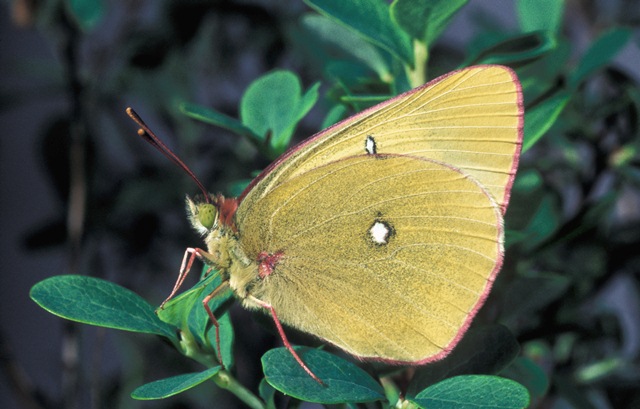 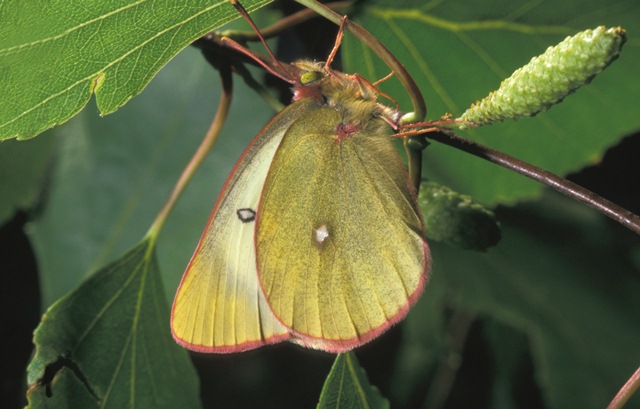 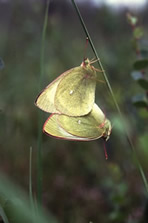
Photographs: Frits Bink, Frits Bink, Christer Wiklund ©.
Medium sized or large, wing length 24 (22-28) mm. The species has disappeared from the Benelux, in 1956 the last butterflies were seen in the Hautes Fagnes. In 1959 and 1970 there were reintroduction trials and some butterflies were seen later; however the species is now extinct in the Benelux, despite the continued existence of a large area of the raised bog with bog whortleberry, its only host-plant.
Butterfly is on the wing from mid-June until end-July. It peaks early-July and occurs in a continental climate, amplitude 8 to 20 Its required minimal heat sum is 90°d and maximal tolerated 650°d and the corresponding climate windows are 11 and 21 weeks.
The species has a circumpolar distribution and occurs in the taiga and sub-arctic tundra and also in the mountainous and alpine climate zones.
Ecological characteristics
Behaviour over time
Overwintering: small larva in L3 or sometimes L4, 8-10 mm in size, under a withered leaf in the litter layer.
Reproduction: oviposition starts after 5-7 days when the body contains about 90 eggs. Estimated maximum production 1.6 times as much.
Larval feeding periods: in summertime 42 (35-48) days in the period of early-July until end-August, in the following spring 35 (22-50) days from early-May until end-June.
Generations: always one.
Spreading of risk: not observed.
Life cycle: egg 8 (5-10) days; larva 47 weeks; pupa 16 (11-21) days.
Life span of adult: short, 2 weeks.
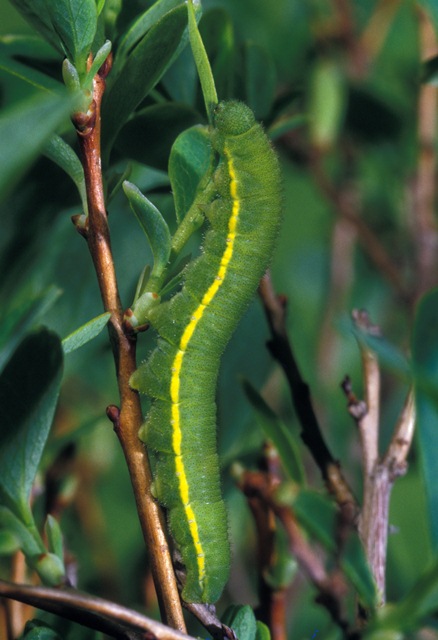 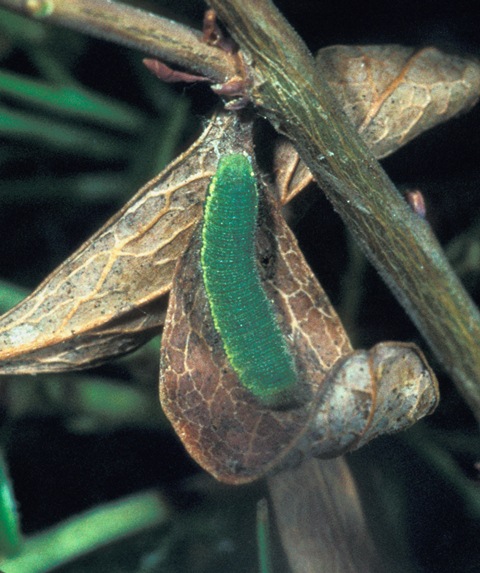
Photographs: Frits Bink ©.
Behaviour in space
From stay-at-home to migrant: nomad which likes to stay in a landscape of a raised bog.
Finding a mate: male patrols.
Orientation in the landscape: between wood and open bog.
Oviposition: eggs are deposited on the upper side of the leaves.
Defence
Threats from other organisms: no defence in the larval stage, the adult has some protection by its yellow or white colour that is repulsive to avian predators.
Threats from the environment: both larvae and adults survive periods of bad weather, but suffer from irregularity in seasonal cycle. It does not occur in a maritime climate.
Feeding habits
Adult: nectar of all kind of flowers, rose bay willowherb (fire weed, Chamerion angustifolium) is an important nectar source.
Larva: the young larva scratches the upper epidermis of the leaf and this makes a typical and easy to recognise pattern. In spring, the larva begins its activity as soon as the buds swell; these are eaten and later the whole sprout will be devoured.
Larval foodplants
Plant species: Ericaceae, Vaccinium uliginosum, the only host.
Journal
Rearing experiments based on 30 eggs, collected 29 June 1986, from a raised bog near Rothenthurn in Canton Schwyz, Switzerland, sent by Jörg Rüekschi:
2 July 1986: Eggs received.
5 July: all eggs hatched.
16 July: one larva now L2.
26 July: 12 larvae present, ending L2.
4 August: a few larvae were in L3.
23 August: 15 larvae present, two of which were still feeding, 7-8 mm in size.
27 August: most larvae in diapause.
Overwintered in an open greenhouse, thus under dry conditions
19 March 1987: first larva active.
25 March: five larvae active, however Vaccinium uliginosum has no buds sprouting. Trial with another species: V. corymbosa was sprouting and the larvae started to feed immediately.
31 March: the buds of V. uliginosum were swelling and eight larvae fed on them.
6 April: all larvae active, one moulting.
20 April: three larvae in last instar, smallest one still in L3.
23 April: first larvae started to pupate, the larvae in the open greenhouse suffered from heat.
29 April: two larvae pupated.
19 May: first adults hatched, one male and one female.
20 May: third one hatched, female.
The rearing trials undertaken in 1983, 1985 and 1986 all failed; the larvae died after the winter. In the autumn the larvae shrunk, in early spring they swelled up due to wetting by rain but died later without any activity.
Keeping them dry during winter in a windy place was very successful and not more than 10% mortality occurred.
Table 19-1. Results of dissections

Table 19-2. Collection and observation localities
EST, Endla Nature Reserve, 58° 52’ 41”N – 26° 12’ 53”E; 10 July 1999.
EST, Endla Nature Reserve, 58° 52’ 34”N – 26° 16’ 21”E; 10 July 1999.
EST, Kuresoo, 58° 28’ 00”N – 25° 11’ 59”E; 8 July 1999.
EST, Mannikjärv 58° 52’07”N – 26° 15’ 37”E; 15 July 1999.
Localities of origin
Germany Peitinger Moor: 11 July 1985 (3 larvae from Kleinecke).
Sweden, Rättvik: 17 July 1983 (3 larvae from Christer Wiklund).
Switzerland, Canton Schwyz, Rothemthurn: 29 June 1986 (30 ova from Jörig Rüeckschi).
Fig. 19-1. Colias palaeno, phenogram adapted from Ebert & Rennwald 1991a: 240.
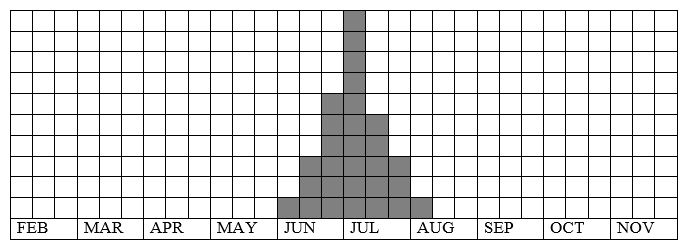
Fig. 19-2. Colias palaeno, habitat characteristics.
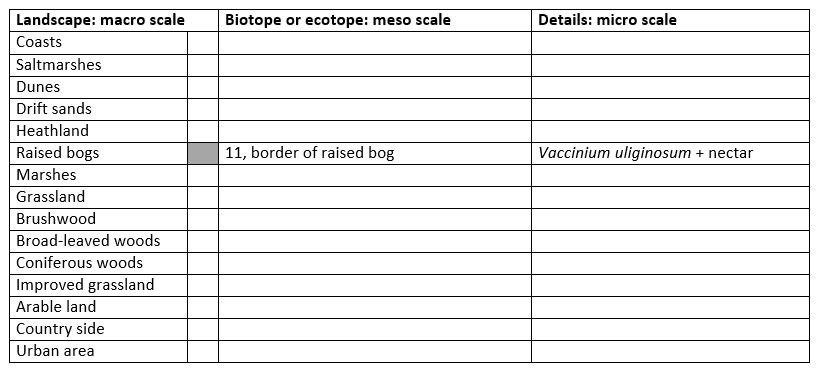
Fig. 19-3. Colias palaeno, climate matrix, heat-sums 90 - 650°d.
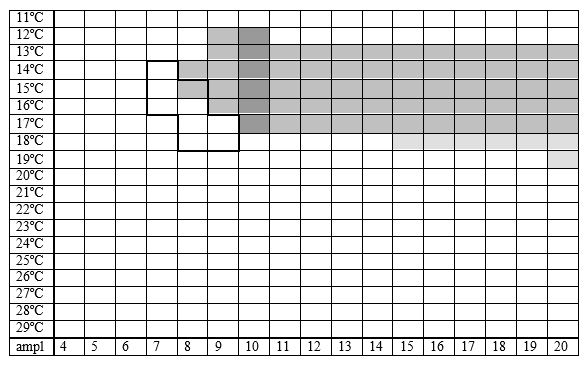
|










